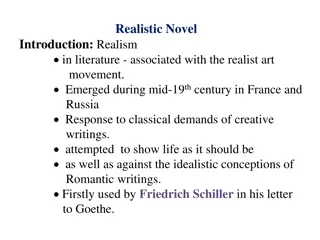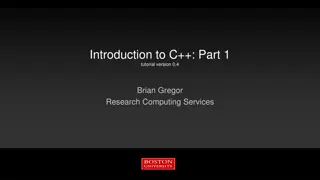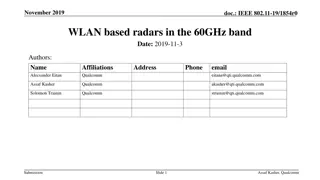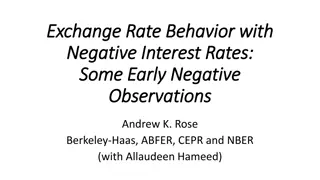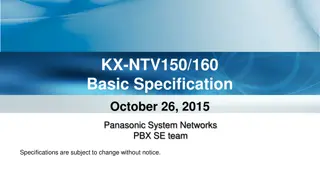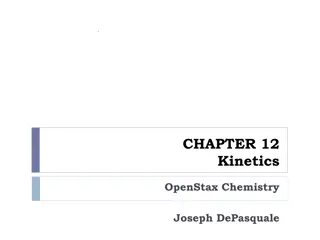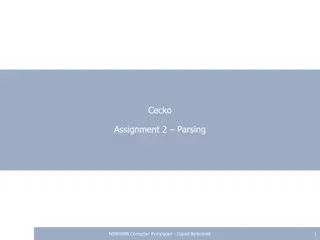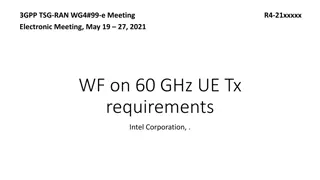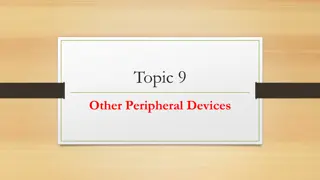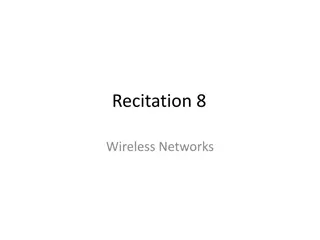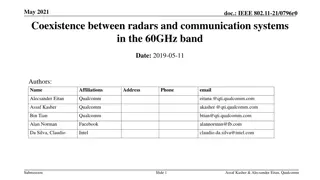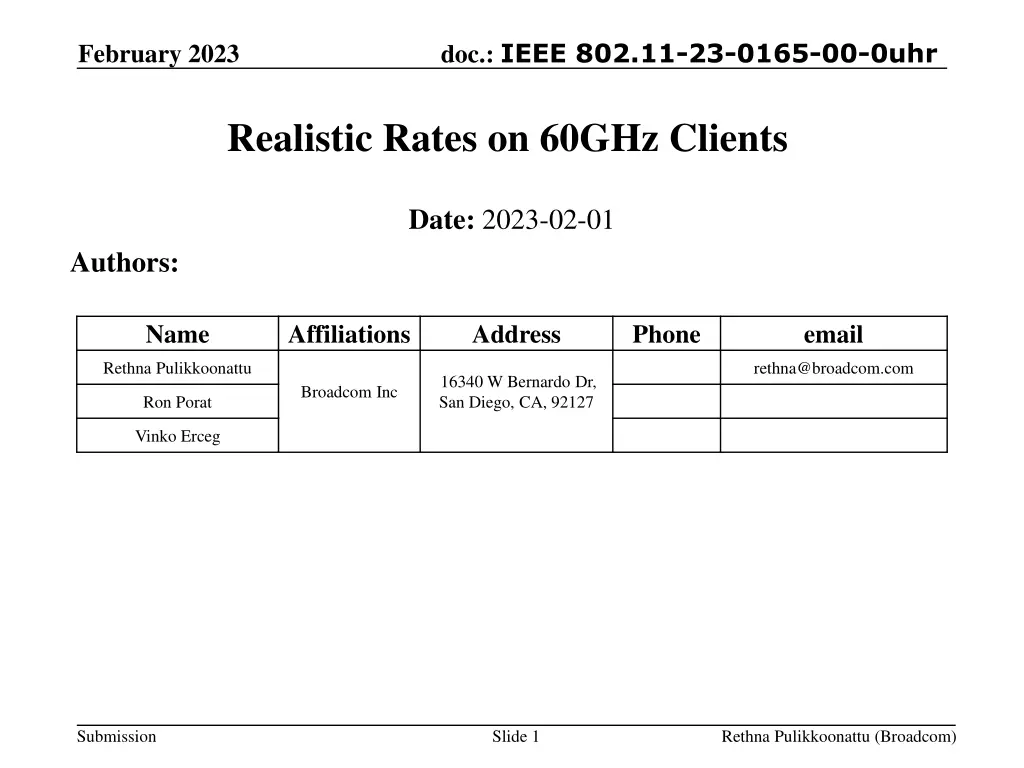
Realistic Rates on 60GHz Clients: A Comparative Analysis
Explore the feasibility of physical transmission rates for 60GHz clients compared to existing 6GHz band solutions. Delve into the challenges and benefits of implementing 60GHz technology, assessing its potential against established alternatives. Analyze the complexities and limitations of supporting 60GHz for next-gen devices, highlighting crucial considerations for hardware enhancements and performance evaluations.
Download Presentation

Please find below an Image/Link to download the presentation.
The content on the website is provided AS IS for your information and personal use only. It may not be sold, licensed, or shared on other websites without obtaining consent from the author. If you encounter any issues during the download, it is possible that the publisher has removed the file from their server.
You are allowed to download the files provided on this website for personal or commercial use, subject to the condition that they are used lawfully. All files are the property of their respective owners.
The content on the website is provided AS IS for your information and personal use only. It may not be sold, licensed, or shared on other websites without obtaining consent from the author.
E N D
Presentation Transcript
doc.: IEEE 802.11-23-0165-00-0uhr February 2023 Realistic Rates on 60GHz Clients Date: 2023-02-01 Authors: Name Affiliations Address Phone email Rethna Pulikkoonattu rethna@broadcom.com 16340 W Bernardo Dr, San Diego, CA, 92127 Broadcom Inc Ron Porat Vinko Erceg Submission Slide 1 Rethna Pulikkoonattu (Broadcom)
doc.: IEEE 802.11-23-0165-00-0uhr February 2023 Abstract This submission offers a fair evaluation of the feasible physical layer transmission rates for 60GHz clients in comparison to existing solutions in the 6GHz band. Submission Slide 2 Rethna Pulikkoonattu (Broadcom)
doc.: IEEE 802.11-23-0165-00-0uhr February 2023 Positing 60GHz in UHR Wider spectrum is available in the 60GHz band. Despite the signal power being allowed to reach a much higher level (~40dBm EIRP), this enhancement is swiftly nullified by the path loss, even at close ranges. The 5-7GHz bands features mature MIMO solutions for the STA market, providing tangible product performance. The implementation of 60GHz for the next generation involves significant changes to hardware, particularly the RF, causing a rise in power consumption, physical size, and cost. To make 60GHz a compelling choice, it is essential to determine its realistic benefits and weigh them against the well-established solutions in the 6GHz band. Submission Rethna Pulikkoonattu (Broadcom) Slide 3
doc.: IEEE 802.11-23-0165-00-0uhr February 2023 60GHz vs 6GHz: PHY Rate Comparisons The complexity of supporting Nss=2 in the 60GHz band, with its demanding area and power needs, would render it inappropriate for handheld devices, even with advanced process nodes. Despite utilizing four times the operating bandwidth, the 60GHz band does not significantly enhance throughput when compared to 5-7GHz band solutions. MCS 11 + 160 (320) MHz + Nss = 2 in 6GHz offers superior rate than MCS 4 + 640 (1280) MHz + Nss=1 in 60GHz MCS 13 + 160 (320) MHz + Nss = 2 in 6GHz offers superior rate than MCS6 + 640 (1280) MHz + Nss=1 in 60GHz Realistic 60GHz Configuration Nss=1, 16QAM and LDPC 3/4, 640MHz (1280MHz) Lower BW is desired after the 802.11ay experience [1,3] PHY based upon 11ac architecture/design [1-4] Reduce the symbol time by a factor of 8 RF Challenges Frequency droop Increased PLL noise (and current) Frequency dependent IQ imbalance Power Amplifier memory, nonlinearity etc., Baseband/Mixed signal challenges Baseband complexity/power scales up RF impairments compensation gets harder Slide 4 Submission Rethna Pulikkoonattu (Broadcom)
doc.: IEEE 802.11-23-0165-00-0uhr February 2023 60GHz vs 6GHz: Feasible PHY Rates Even with four times the operating bandwidth, the 60GHz band still struggles to deliver practical throughput numbers that can compete with what is possible in the 5-7GHz band, despite the extra complexity and work involved. Notes The PHY parameters in this 60GHz design are based on a scaled-up version of the 802.11ac 80MHz PHY, without any limitations from the RF. The mapping of MCS in this design aligns with the that of 802.11ac/ax/be. 6GHz rates are for EHT The RF noise limitation to support MCS6 in 60GHz is similar or equivalently harder than supporting MIMO MCS13 in 5-7GHz The maximum PHY rate in Mbps is represented by R, while the PHY bandwidth in MHz is represented by BW. The operating band in GHz is denoted by the column "band". Submission Rethna Pulikkoonattu (Broadcom) Slide 5
doc.: IEEE 802.11-23-0165-00-0uhr February 2023 Conclusion A transition to the 60GHz band, even with four/eight times more operating bandwidth than in the 5-7GHz bands, does not result in substantial benefits in terms of throughput. The pursuit of wider bandwidth in 60GHz, even at realistic rates (Nss=1, MCS=4), presents significant hurdles, particularly for client devices. Spending effort in 60GHz does not seem like a wise choice, as the benefits it offers in realistic scenarios are modest compared to what can be achieved with the new and unoccupied 6GHz band. Submission Slide 6 Rethna Pulikkoonattu (Broadcom)
doc.: IEEE 802.11-23-0165-00-0uhr February 2023 References 1. 2. 3. 4. mmWave operation in UHR IEEE 802.11-22/1595r1 Thoughts on Utilizing mmWave IEEE 802.11-23/0066r0 Considerations on PHY designs for mmWave band , IEEE802.11-22/1872r0 Some questions to answer in the SG , IEEE802.11-22/1595r1 Submission Slide 7 Rethna Pulikkoonattu (Broadcom)



